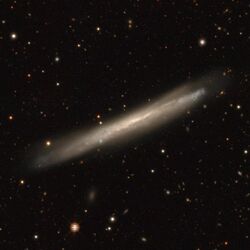Astronomy:NGC 3044
| NGC 3044 | |
|---|---|
 legacy surveys image of NGC 3044 | |
| Observation data (J2000 epoch) | |
| Constellation | Sextans |
| Right ascension | 09h 53m 40.884s[1] |
| Declination | +01° 34′ 46.74″[1] |
| Helio radial velocity | 1,289 km/s[2] |
| Galactocentric velocity | 1,130 km/s[2] |
| Distance | 67 Mly (20.6 Mpc)[2] |
| Group or cluster | Leo Cloud[3] |
| Apparent magnitude (V) | 12.5[4] |
| Apparent magnitude (B) | 12.4[5] |
| Characteristics | |
| Type | SBc[6] |
| Mass | 6.4×1010[7] M☉ |
| Notable features | Edge-on galaxy |
| Other designations | |
| IRAS 09511+0148, NGC 3044, UGC 5311, MCG+00-25-031[8] | |
NGC 3044 is a barred spiral galaxy in the equatorial constellation of Sextans. It was discovered on December 13, 1784, by German-born English astronomer William Herschel.[9][10] In 1888, Danish astronomer J. L. E. Dreyer described it as "very faint, very large, very much extended 122°".[11] It is located at an estimated distance of 67 million light years.[2] In the B band of the UBV photometric system, the galaxy spans 4.70′ by 0.80′[5] with the major axis aligned along a position angle of 113°.[7] It is a relatively isolated galaxy with no nearby companions.[7] R. B. Tully in 1988 assigned it as a member of the widely displaced Leo Cloud.[3]
The morphological classification of NGC 3044 is SBc,[6] indicating a barred spiral (SB) with somewhat loosely-wound spiral arms (c). It is being viewed edge-on, with a galactic plane that is inclined at an angle of 79°±4° to the line of sight from Earth.[12] The disk appears lob-sided and disturbed, suggesting a recent merger or interaction. There is a diffuse ionized gas extending to 1 kpc above the center of the plane.[7]
The stars in the galaxy have a combined mass of approximately 1.01×1010 M☉,[6] and the star formation rate is 2.77 M☉·yr–1.[6] The total mass of the atomic gas in this galaxy is 3.5×109 M☉,[7] and it has a dust mass of 1.6×108 M☉.[3] The galaxy as a whole has a dynamic mass of 6.4×1010 M☉.[7]
A supernova was observed on March 13, 1983, at an offset 29″ east, 11″ south of NGC 3044.[13] Designated SN 1983E, it was a suspected type II supernova that reached a peak magnitude of 14.9 (B) around March 15.[14]
References
- ↑ 1.0 1.1 Skrutskie, Michael F. et al. (February 1, 2006), "The Two Micron All Sky Survey (2MASS)", The Astronomical Journal 131 (2): 1163–1183, doi:10.1086/498708, ISSN 0004-6256, Bibcode: 2006AJ....131.1163S.
- ↑ 2.0 2.1 2.2 2.3 Tully, R. Brent et al. (August 2016), "Cosmicflows-3", The Astronomical Journal 152 (2): 21, doi:10.3847/0004-6256/152/2/50, 50, Bibcode: 2016AJ....152...50T.
- ↑ 3.0 3.1 3.2 Irwin, J. A. et al. (August 2013), "The 617 MHz-λ 850 μm correlation (cosmic rays and cold dust) in NGC 3044 and NGC 4157", Monthly Notices of the Royal Astronomical Society 433 (4): 2958–2974, doi:10.1093/mnras/stt937, Bibcode: 2013MNRAS.433.2958I.
- ↑ Cavin, Jerry D. (2011), The Amateur Astronomer's Guide to the Deep-Sky Catalogs, Springer New York, p. 167, ISBN 9781461406563, https://books.google.com/books?id=obLAoHOVodAC&pg=PA167.
- ↑ 5.0 5.1 Nilson, Peter (1973), "Uppsala general catalogue of galaxies", VizieR On-line Data Catalog: VII/26D, Bibcode: 1995yCat.7026....0N.
- ↑ 6.0 6.1 6.2 6.3 Hodges-Kluck, Edmund et al. (December 2016), "Ultraviolet Halos around Spiral Galaxies. I. Morphology", The Astrophysical Journal 833 (1): 58, doi:10.3847/1538-4357/833/1/58, 58, Bibcode: 2016ApJ...833...58H.
- ↑ 7.0 7.1 7.2 7.3 7.4 7.5 Zschaechner, Laura K. et al. (January 2015), "Investigating Disk-halo Flows and Accretion: A Kinematic and Morphological Analysis of Extraplanar H I in NGC 3044 and NGC 4302", The Astrophysical Journal 799 (1): 61, doi:10.1088/0004-637X/799/1/61, 61, Bibcode: 2015ApJ...799...61Z.
- ↑ "NGC 3044". SIMBAD. Centre de données astronomiques de Strasbourg. http://simbad.u-strasbg.fr/simbad/sim-basic?Ident=NGC+3044.
- ↑ Erdmann, Jr., Robert E. (December 2006), "NGC Discoverer's List", The NGC/IC Project, https://ngcicproject.observers.org/erdmann/NGC_Discoverers_01.txt, retrieved 2023-03-05.
- ↑ Seligman, Courtney (Aug 25, 2021), NGC Objects: NGC 3000 - 3049, https://cseligman.com/text/atlas/ngc30.htm#3044, retrieved 2023-03-05.
- ↑ Sulentic, Jack W. et al. (1973), The Revised New Catalogue of Nonstellar Astronomical Objects, Tucson: University of Arizona Press, Bibcode: 1973rncn.book.....S.
- ↑ Singal, J. et al. (November 1989), "Axial Ratio of Edge-On Spiral Galaxies as a Test for Bright Radio Halos", Astronomy and Astrophysics Supplement Series 81: 51–58, Bibcode: 1989A&AS...81...51H.
- ↑ Kosai, H. et al. (April 1983), Marsden, B. G., ed., "Supernovae", IAU Circular 3789 (1), Bibcode: 1983IAUC.3789....1K.
- ↑ Barbon, R. et al. (December 1989), "The Asiago supernova catalogue.", Astronomy and Astrophysics Supplement Series 81: 421–443, Bibcode: 1989A&AS...81..421B.
Further reading
- NGC 3044, Queen's University, https://www.queensu.ca/changes/ngc-3044/, retrieved 2023-03-04.
- Krause, Marita et al. (July 2020), "CHANG-ES. XXII. Coherent magnetic fields in the halos of spiral galaxies", Astronomy & Astrophysics 639, doi:10.1051/0004-6361/202037780, A112, Bibcode: 2020A&A...639A.112K.
- Lee, Siow-Wang; Irwin, Judith A. (November 1997), "Neutral Hydrogen in the Edge-on Spiral Galaxy NGC 3044--Global Properties and Discovery of H I Supershells", The Astrophysical Journal 490 (1): 247–262, doi:10.1086/304840, Bibcode: 1997ApJ...490..247L.
- Lee, S.; Irwin, J. A. (December 1996), "Neutral hydrogen in the edge-on spiral galaxy NGC 3044: global properties and the discovery of H I supershells.", Journal of the Royal Astronomical Society of Canada 90: 325, Bibcode: 1996JRASC..90R.325L.
 |

